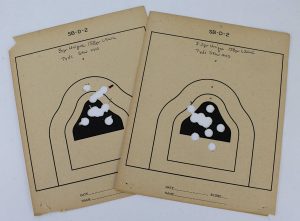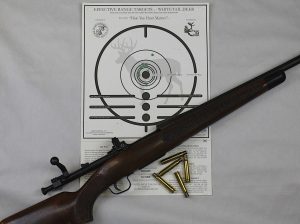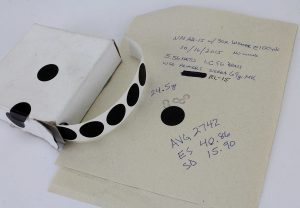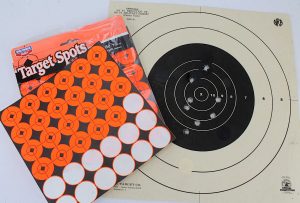By Art Merrill | Contributing Editor
“The proof of the pudding is in the eating,” is a saying that goes back to the days when the matchlock was the first “assault rifle.”
For handloaders, the pudding is the ammunition and the groups on the target represent the eating. The difference between eating pudding and testing ammunition is that it doesn’t really matter how we eat dessert, but shooting at the wrong kind of target can result in a mistaken conclusion that our handloads won’t group well.
Aiming at buttons

“Re-purposed” milsurp 1,000-inch targets adapt well to precise aiming with handgun iron sights.
We routinely see shooters using targets that aren’t really ideal for checking the accuracy of their firearms or the precision of their factory ammo or handloads. Of course, we don’t always care about “ideal” when target shooting, but evaluating our handloads really calls for a target that will enable us to shoot the smallest group possible, and for this purpose, less is more.
In the Mel Gibson movie, The Patriot, character Benjamin Martin and his two pre-teen sons ambush a column of British soldiers to save Martin’s captured eldest son. While prepping their flintlocks, Martin asks his boys, “What did I tell you boys about shooting?” to which they respond in unison, “Aim small, miss small.”
The statement is a contraction of a combat shooting philosophy that says if you aim at a man and miss, you miss the man, but if you aim at his coat button and miss, you still hit the man. That advice about precision shooting applies to paper targets, as well, when shooting for the smallest possible groups. When checking handloads for precision, it’s best to aim at a button.
A paper target with a round, black, 12-inch bullseye set up 100 yards away from a scoped rifle is not most conducive to encouraging precision aiming, and if we don’t aim precisely we aren’t going to allow our handloads to demonstrate their true precision. That is, aiming at a too-large target can cause groups to enlarge, leading to a mistaken conclusion that our handload is no good or that the firearm “won’t shoot.” For this reason, when testing ammunition or firearm precision, I use the smallest possible target that I can see clearly, as dictated by my distance from the target and the sights on the firearm.
Pasters: inexpensive, ideal
For scoped rifles, I use a simple, cheap black target paster on a blank white background. That background might be a common sheet of 8×11 inch paper, but I prefer to cover the entire cardboard target backing with paper from an end roll I pick up at a local newspaper print facility. End rolls are the last 100 feet or so of paper on a giant roll of newsprint, which sell for about $5. The paper completely covers all the old bullet holes in the cardboard so that I can clearly see my own first shots if they are well off the target center.
Shooters use self-adhesive pasters to cover the bullet holes in paper targets after scoring a shot or shots; they get the most use out of a target, as at less than a penny apiece, pasters are far cheaper than targets. Round pasters are about ¾ inch in diameter; that may sound too small for even a scoped rifle, but they are excellent at 100 yards with enough magnification. It depends on your own eyesight and the thickness and type of scope crosshair, but they work with scope magnification down to around 9x or so.
On-grid

ERT targets are a realistic check of your hunting marksmanship skill.
I’ve also utilized the grid style targets intended specifically for use with scoped firearms. The grid squares are typically one inch across, which is handy for scopes that have their adjustments graduated in ¼-, ½- or one-inch increments, and for quick reference in seeing a group’s size. With these targets, at higher magnifications I don’t aim for the middle of the square in the center of the target; rather, for precise aiming I place the crosshair on one corner of that center square.
Stepping down in magnification means stepping up in the size of the target, and placing a target further away also requires enlarging the target size. This is a great application for those peel & stick targets that offer a variety of sizes in a single packet. They’re also great for bore sighting a firearm at, say, 25 yards, then as we move the target frame further downrange, sticking on larger targets, if needed, as the range increases.
Clutter distracts
A too-large black area and a heavy, black, unlighted reticle are not a good combination for precise aiming. Something else to consider is that many targets have too much visual clutter that can be distracting when aiming for precision. The clutter and colors give the targets eye-catching marketability when hanging on store racks, but mostly serve no useful purpose for aiming. However, viewed without magnification, their “busyness” is usually no factor, and they’re fine for aiming with handgun and rifle iron sights. Round targets work well with rifles mounted with (round) aperture rear sights.
For iron-sighted handguns, I discovered milsurp WWII-era “1,000-inch” targets work very well for me. I acquired my stash many years ago, and I doubt they are any longer available; I mention them to encourage you to keep your eyes open for a similar bargain on simple targets that serve the purpose for you.
Effective Range Targets

Target pasters on newsprint endroll paper make for uncluttered “button” aiming points for scoped rifles and handguns.
Doubtless, even a small gathering of shooters could have endless discussion about what targets are best for which applications and types of sights. Let’s change the subject somewhat from technical precision to hunting field marksmanship.
A fine handload that can hold the mark at 600 yards is no guarantee that the shooter can, too. The present continuing trend in shooting big game at longer ranges brings up an important question: what is the effective range of your marksmanship skill in delivering a bullet into a game animal’s vital heart-lung area for a humane harvest? An easy way to find out – and to simulate the challenge – is with the Effective Range Target from JMA Outdoors.
“Effective range” refers to the furthest distance at which a cartridge, firearm and/or shooter can reliably hit a target. For the big game hunter, a realistic target for determining effective range is a roughly nine- to 12-inch circle representing the general heart-lung area of many big game species. Since a lot of folks don’t have access to ranges allowing them to shoot beyond 200 yards, a logical method for determining at 100 yards whether their effective range may be 400 or 600 yards is to reduce the size of the target. This is the function of the Effective Range Target (ERT).
Set up 100 yards from the shooter, the concentric rings on the ERT represent the big game animal’s apparent-size vital area at different distances. The outermost ring is the vital area at 100 yards, the next inner ring is the size of the vital area as it would appear if the animal were actually 200 yards away, and so on, down to a 1 ¼ inch ring in the center representing a 600-yard apparent vital area.
The ERT is not a test of your rifle or cartridge performance over distance, and it does not take into account wind drift, uphill/downhill angle, and other factors impacting a long range shot. Rather, it is a method of testing your own marksmanship skill in shooting from field positions you might expect to use in the real world – standing unsupported, supporting the rifle on a tree branch, kneeling, prone, whatever. It is designed for use with a scoped rifle or handgun; If you’ve already zeroed your scope for shooting at longer range, the heavy black dots and horizontal lines below the center allow holding lower to place shots in the center.

One-inch peel & stick targets work well with lower scope magnifications to 100 yards. NRA’s reduced High Power bullseye targets are excellent for aiming with iron sights at that distance.
Checking your marksmanship skill with the ERT can be a confidence booster or an eye-opener. The ERT is a good tool for demonstrating to new hunters the difficulty in making a humane shot as range increases, and so is an excellent training device for a hunter safety course. It can also serve as constructive entertainment when we bring a hunter friend and a few ERTs to the range for a session of beyond-the-routine target shooting.
“Effective range is the ethical distance in which you can realistically commit to a shot and expect a one shot, humane kill,” JMA Outdoors printed on their ERT.
Also printed nearby is their mission, which is to, “Create a family owned company that is committed to provide outdoor products that are innovative, enhance the outdoor experience, elevate sportsmanship, emphasize responsible hunting and promote the preservation of our hunting and shooting heritage.” Who would have thought all that could be exemplified in a simple paper target?
JMA Outdoors prints the ERTs on heavy stock in sizes that represent the vital areas of deer, elk, hogs, coyotes and more. For more information and to order Effective Range Targets, visit www.EffectiveRangeTargets.com.



